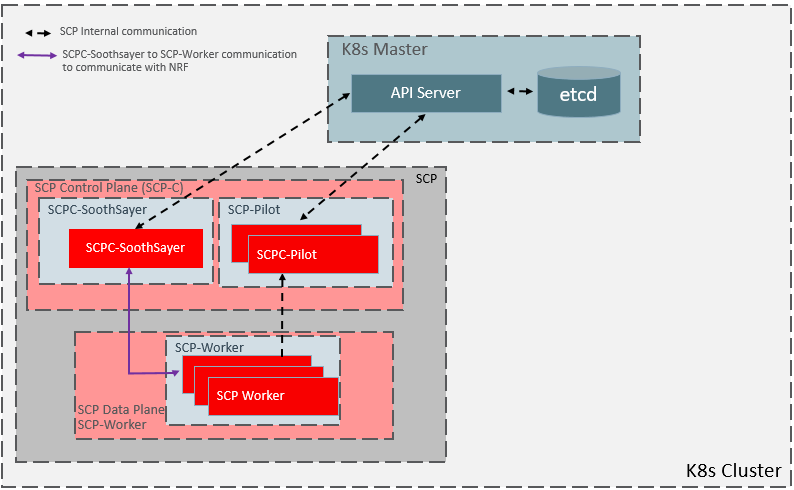| Oracle® Communications Service Communication Proxy (SCP) Cloud Native User's Guide Release 1.0 F12310-01 |
|
 Previous |
 Next |
| Oracle® Communications Service Communication Proxy (SCP) Cloud Native User's Guide Release 1.0 F12310-01 |
|
 Previous |
 Next |
This section explains the Service Communication Proxy system architecture.
The Service Communication Proxy is a decentralized solution and composed of control plane and data plane. This solution is deployed along side of 5G Network Functions (NF) for providing routing control, resiliency, and observability to the core network. The Service Communication Proxy has a control plane and a data plane.
Figure 2-1 Service Communication Proxy Architecture

The Service Communication Proxy solution is deployed either as a default outbound proxy to NF instances or as a router model where SCP is configured as http2 outbound proxy at each NFs in cloud native environments. SCP provides the following benefits to the 5G core network architecture:
Improved Load Balancing
The 5G core network is a service based architecture which does not lend itself to an efficient load balancing of provider NFs and by introducing an Service Communication Proxy in the midst, load balancing across available NFs can be significantly improved. The Service Communication Proxy has a complete view of all the messages arriving for a given NF type and supports schemes such as round robin, weighted round robin, transaction latency, etc while factoring in the current load and NF availability.
Routing Control
By leveraging its position in the network, the Service Communication Proxy provides better routing control and bring resiliency to the network. It relieves user NFs from remembering and interpreting complex routing rules associated with next hop selection and at the same time makes re-routing decisions based on load conditions and health status of NF providers.
In the absence of an alternate route, the Service Communication Proxy rejects requests destined to a failed or degraded NF, thereby acting as a circuit breaker. This prevents valuable resources at the user NFs from being tied up waiting for responses from providers. The Service Communication Proxy can also perform Retries on behalf of the service user there by relieving the service user from this burden and leaving it to focus on the application.
Message Priority Assignment/Override
3gpp-Sbi-Message-Priority header is defined to carry the message priority of 5G messages. The SCP includes or modifies the header based on the configuration parameters. See Configuring MessagePriority Options.
Circuit Breaking and Outlier Detection
Service Communication Proxy tracks the status of each individual endpoint of the producer NFs/NF Services. Upstream producer EndPoints that continually return 5xx errors for service requests are ejected from the routing pool for a pre-defined period of time. Outlier detection is a form of passive health checking of producer NFs. Outlier detection is per endpoint (of producer NF instance) and triggers when SCP receives consecutively 5xx error response and exceeds the configurable number of consecutive 5XX errors.Overload Control
The overload control protects the pod (server) from overload with respect to various system resources such as memory, CPU, or file descriptors due to several client connections or requests.
The SCP worker and controller supports overload control based on the usage of below listed resources:
The SCP worker and controller considers itself to be overloaded if the usage associated with memory, CPU or File descriptors exceeds the operator configured threshold values.
In the event of overload, the SCP performs the below configured actions
Observability
The following are available in observability.
Metrics services requests are proxied through the Service Communication Proxy, the Service Proxy Controller can collect Metrics and KPIs related to message processing. With this information, the Service Communication Proxy is in a unique position to provide a view of health status the network at a given time. See Metrics, KPIs, and Traces.
Compliant with open API tracing
Compliant with ELK stack.